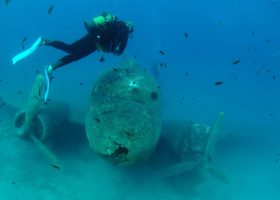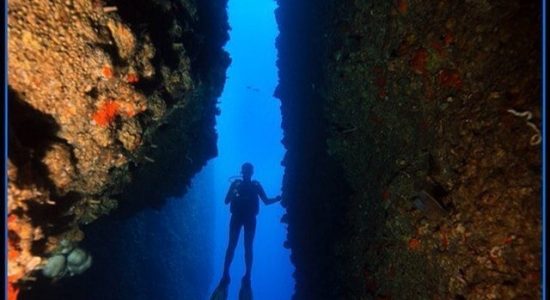Hoşgeldiniz - Welcome!
Mediterranean and Aegean coasts of Turkey, are the best places to dive. It is also possible to dive to shipwrecks from World War I (with special permission of local authorities) in Gallipoli, Canakkale. Diving for purposes of sport, with proper equipment and in non-restricted areas, is permitted. Foreign divers should have official documentation of their qualification, training and must be accompanied, when diving, by a licensed Turkish guide. In order to protect Turkish archaeological and cultural treasures, it is strictly forbidden to transport or export Turkish antiquities or natural specimens. Info Source by visitturkey.in
Best time to dive?
All the destinations on in Turkey should ideally be visited between April and October when sea water temperatures range from 17C to 28C. Gallipoli, however, will be colder averaging around 14C. During these times, many diving schools and companies are open for business, whereas they close in the winter time, which is outside of the tourism season.
Info Source by turkeyhomes.com
Best time to Dive?
All the destinations on in Turkey should ideally be visited between April and October when sea water temperatures range from 17C to 28C. Gallipoli, however, will be colder averaging around 14C. During these times, many diving schools and companies are open for business, whereas they close in the winter time, which is outside of the tourism season.
Info Source by turkeyhomes.com
- {{ listingType.name }}
- prev
- next
Do you offer Diving services?
Promote your services and connect with divers
Are you a Scuba diver?
Join and get the best benefits for your next trip
Do you offer Diving services?
Promote your services and connect with divers
Are you a Scuba diver?
Join and get the best benefits for your next trip
Sea Life
One of the good things about scuba diving sites in Turkey is that the water is clear and warm. There is also a variety of sea life to beMarine life and scuba diving in Turkey seen when Scuba diving at sites in Turkey including Barracuda, Sea bream and Octopus. However, the level of sea life at scuba diving sites is typical of other Mediterranean scuba diving sites such as Spain and not as much sea life can be seen as in scuba diving sites in the Red Sea or Caribbean.
Info source by tourismguideofturkey.com
Dive Sites
Discover the hidden treasures of Turkey’s mysterious waters, from its exotic marine life to its secret caves. Dive its depths and revel in the colourful corals of the Mediterranean, or get lost in historical World War I wreckages nestled within the seabed of the Aegean.
Suitable for beginners and experts alike, scuba diving in Turkey will allow all levels to explore its ocean floor. There are over 125 shipwrecks spread across this idyllic coast dating back to the 14th century BC. Info source by broadwaytravel.com










Gallipoli
Turkey has 125 listed shipwrecks around its coastline, and no more so than off the north-west coast of the Gallipoli Peninsula. The abundance of wrecks here, mostly date from battles in 1915 during the First World War when Britain, using the Canakkale Straits, tried to take Istanbul.
Cesme
Cesme offers up the clarity of water very rarely found and a diverse range of marine species. Dive sites including the Bedroom, a spectacular cave particularly loved by underwater photographers and Split Rock at Eşek Island where experienced divers can go down 45 metres.
Bodrum
Diving gets better and better the further south you go, and Bodrum is no letdown. There are around 20 dive sites off the Bodrum peninsula featuring two shipwrecks, a plane, walls, caverns and pinnacles. With dive depths, up to 30 metres, you will be well-placed to see the likes of stingray, barracuda, tuna, moray eels and octopus.
Fethiye
The blue depths off Fethiye hide some great dives. These include Afkule for those in search of corals, sponges and caverns. The aptly named Secret Garden is a 25-metre cavern with a ceiling of 6 meters, while Aladdin’s Cavern offers a veritable feast of flora and fauna.
Kas and Kalkan
Of the 15 dive sites around this part of the Mediterranean, there is an abundance of reefs, walls, underwater canyons and beautiful landscapes. Said to be one of the world’s top 10 diving sites, there is the bonus of an Ottoman shipwreck and the mystery of the Sakarya/Duchess of York’s vessel, a steamship that ran aground in May 1943. Heybeli Island, near Kalkan, offers a rocky landscape for divers to explore.
Antalya
Antalya is a diving enthusiast’s dream because it has everything from A-Z that an underwater wish list should have. From Kemer’s Aquarium Bay, a 12-metre underwater wonderland of marine life to the Lighthouse Tunnel, a natural maze of tunnels and caves, there is also the Paris II shipwreck which sank in September 1917.
Dive sites info source by turkeyhomes.com
How to Arrive
You can travel to Turkey in many different ways: by road, plane, train or sea. Major roads link Turkey with Europe and Asia. The country’s international airports provide top-notch services. Rail connections with Europe and Middle East are very few but can give you a nostalgic journey. Turkish ports welcome several cruise ships and local ferries all year round.
By far the fastest and easiest way to get to Turkey is to fly; there are direct flights to a variety of Turkish destinations from all major capitals and cities of the world. Various International Airlines have regular flights to Istanbul, Ankara, Izmir, Antalya and Dalaman airports. Train journeys can be made to Istanbul from and via some of the major cities in Europe, with a connection in Greece. There are also trains to Iran, with connections. Info Source by allaboutturkey.com

